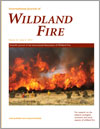
International Journal of Wildland Fire
Volume 22 Number 2 2013
WF11142Effect of land-cover change on Africa's burnt area
We used 5-year MODIS observations to analyse the effects of land conversion, from natural vegetation to agriculture, on the extent of areas burned in Africa. The results show that, in the vegetation units most affected by fire, the decrease in annual area burnt is related to the increase in agricultural land.
WF11165Satellite-based comparison of fire intensity and smoke plumes from prescribed fires and wildfires in south-eastern Australia
Satellite-derived measurements were used to compare prescribed fires and wildfires with respect to intensity and smoke plume area for the regions around the Australian cities of Melbourne and Sydney. Both fire types formed a continuum of intensity and plume size. We suggest that overall smoke plume area from the landscape is substantially smaller from prescribed than from wildfires.
WF11072Smoke plume height measurement of prescribed burns in the south-eastern United States
Smoke plume height is important for understanding and simulating smoke effects on air quality. Plume height was measured using a ceilometer for prescribed burns in the south-eastern US. Average smoke plume height is ~1 km and trends upward from winter to summer, that being opposite to the seasonal trend in smoke intensity. Smoke plume height fluctuates at the time scales from minutes to hours for most burns.
WF11055Field validation of a free-agent cellular automata model of fire spread with fire–atmosphere coupling
A fast, simple, free-agent CA fire model is described and validated with an experimental grassfire, FireFlux. The model accurately simulated observed fire behaviour (spread rate, fire line depth and fire intensity) and bulk patterns of measured time-series of 2-m winds at two towers. Spatial windfields compared favourably with results from full-physics fire models.
WF11097Measurements of convective and radiative heating in wildland fires
Detailed measurements of convective and radiative heating rates in wildland fires are presented. Results indicate that the relative contribution of each to total energy release is dependent on fuel and environment.
WF12034The effect of sampling rate on interpretation of the temporal characteristics of radiative and convective heating in wildland flames
The effect of sampling rate on interpretation of peak and average heating in wildland flames were explored. Results indicate that sampling rate is critical when considering temporally dependent response but less critical to average or cumulative response.
WF11178Wildfire ignition-distribution modelling: a comparative study in the Huron–Manistee National Forest, Michigan, USA
We compared three wildfire ignition distribution models for a national forest in Michigan, USA, in terms of their predictive accuracies, variable rankings and prediction maps. Although predictive accuracies and variable rankings were similar among models, prediction maps varied considerably, highlighting the potential need to compare multiple models for wildfire ignitions.
WF10099Influence of short-interval fire occurrence on post-fire recovery of fire-prone shrublands in California, USA
Frequently burned chamise chaparral shrublands in San Diego County, California, were mapped and analysed to investigate changes in vegetation condition and composition associated with short intervals between fires. Results indicate that chamise chaparral is vulnerable to alteration and type conversion when fire return intervals are 4–5 years or less.
WF11164Fire history in the Araucaria araucana forests of Argentina: human and climate influences
Although many studies have reconstructed fire history in different forest types of Patagonia, little is known about fire regime in the Argentinean Araucaria araucana forests. In this study, fire history in ten sites was reconstructed and fire frequency was analysed in relation to human activities and major climate forcing.
WF11181Fire return intervals within the northern boundary of the larch forest in Central Siberia
A fire history of northern larch forests in Central Siberia was studied. The average fire return interval was found to be 295 ± 57 years, decreasing with latitude decrease. Post-Little Ice Age warming caused an approximate doubling of the fire frequency.
WF11075Estimating US federal wildland fire managers’ preferences toward competing strategic suppression objectives
A stated preference survey of US federal wildfire managers was used to study the tradeoffs managers are willing to make among a variety of fire-suppression objectives, including protection of homes and a highly valued watershed, personnel safety, fire duration and suppression cost.
WF11041Airtankers and wildfire management in the US Forest Service: examining data availability and exploring usage and cost trends
In this manuscript, we explore the availability and sufficiency of extant USA federal land management agency aviation data to track airtanker use and cost trends. Recent aviation and incident records indicate that the use of airtankers tends to occur on extended attack and large-fire support rather than the intended primary use of initial attack. Improved data collection on flight objective and drop locations is recommended.
WF11182The effects of personal experience on choice-based preferences for wildfire protection programs
Results from a stated preference survey indicate that most homeowners in Florida living in fire-prone communities tend to under-invest in programs designed to reduce wildfire risk. Willingness to pay for wildfire protection programs increases for homeowners who have prior personal experience with the consequences of wildfire. Therefore, these people may be influential in encouraging other community members to invest in wildfire protection.
WF11098Econometric analysis of fire suppression production functions for large wildland fires
Fireline production rates are used in decision making for fire suppression activities. Both the under and over utilisation of fire suppression inputs can have substantial consequences for the cost of fire suppression. This paper finds that standard fireline production rates are much greater than the rates estimated using economic production models.
WF11070Bark beetle outbreaks, wildfires and defensible space: how much area do we need to treat to protect homes and communities?
Given the goal of protecting homes from wildfire, eliminating flammable vegetation around all homes in the western US (which would reduce fire risk) would require treating a much smaller area than if beetle-affected forests (>98% of which are in remote areas) were prioritised (which would not reduce fire risk).



